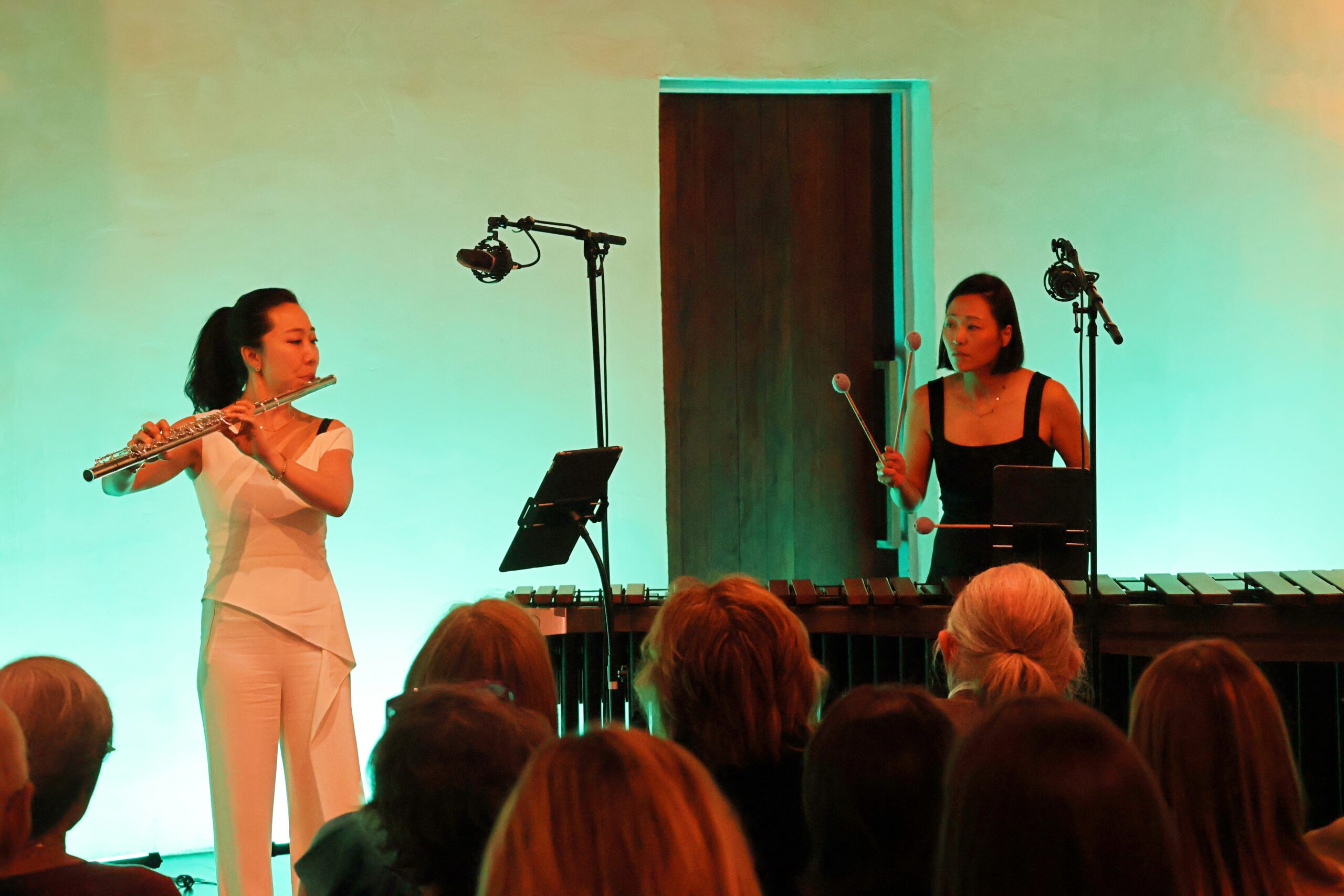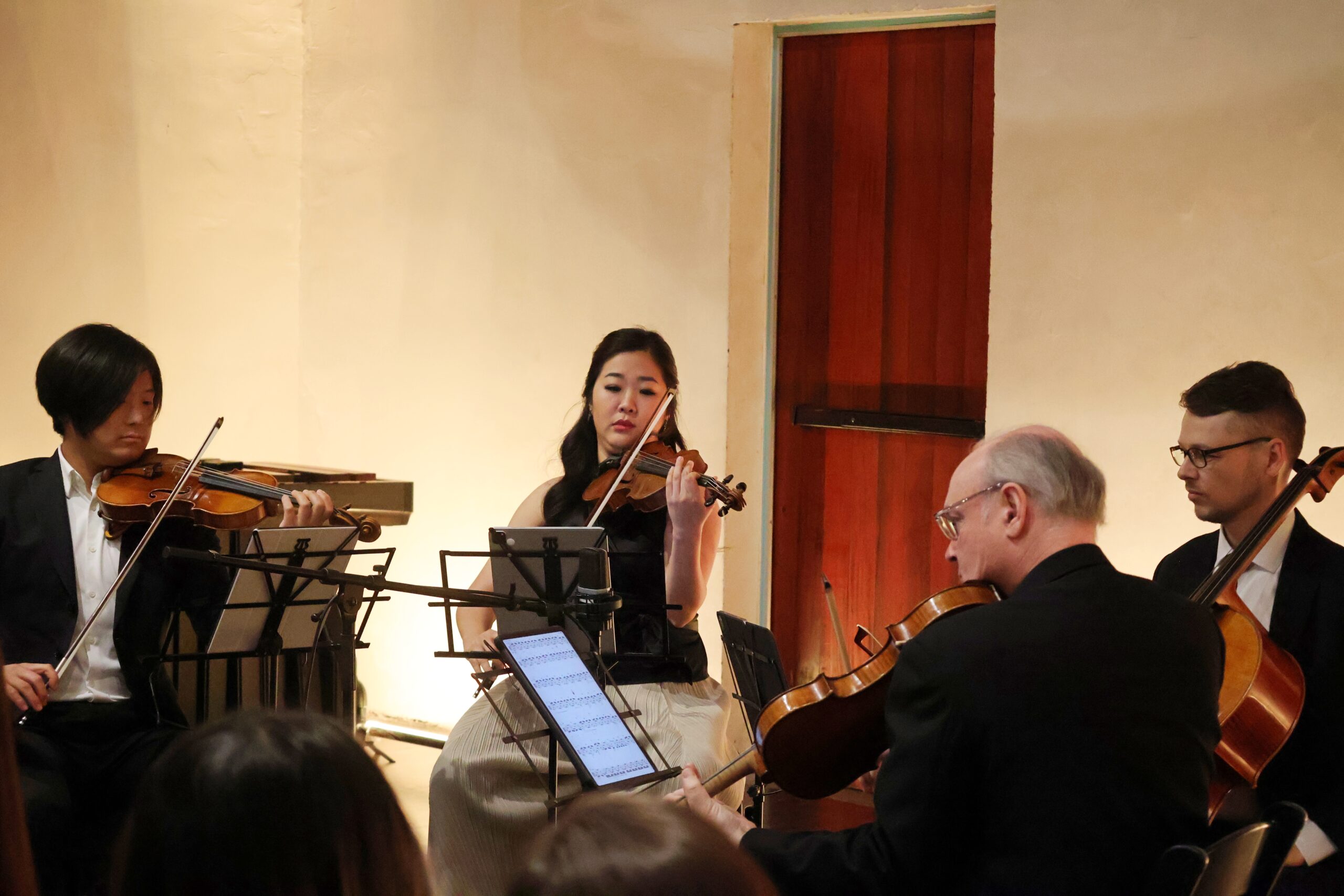New in the Music City
Chamber Music City’s Spring Concert: ars pro nobis
On Thursday May 2, Chamber Music City, a new chamber music organization helmed by Percussionist Ji Hye Jung, gave its premier production at the chic Ruby Nashville venue in the West End. Upon reading her stated mission to produce “innovative programming, unforgettable performances, and community” by “bringing a new type of musical experience to Nashville,” I wondered that, in her ten years up in Blair’s ivory tower, Prof. Jung has still not heard of Intersection, Chatterbird, Alias or the Nashville Chamber Society. That said, even if Chamber Music City isn’t the only shining light on the Music City’s skyline, that doesn’t mean there isn’t a place and space for an ensemble “centered around diverse programming of music old and new performed by globally renowned artists.” And their first concert introduced the ensemble’s ideals quite nicely to the scene with a program of quite diverse music spanning the long 20th and 21st centuries and featuring works by Antonin Dvořák, Caroline Shaw, Toru Takemitsu, and Gemma Peacocke.

After a preconcert discussion with the evening’s musicians, led by Radiolab’s Jad Abumrad, the evening opened with Gemma Peacocke’s Fear of Flying (2020), for alto flute and electronics. Peacocke’s work was composed from the inspiration of a poem of the same name by Teresia Teaiwa which was written in “broken Gilbertese,” an Oceanic language of the inhabitants of island regions in the South Pacific. Sooyun Kim’s performance was excellent, with a warm tone that blended well and a facility of technique that kept a comfortable pace with what might otherwise have been an unforgivingly ferocious electronic track. Personally, I wasn’t a fan of this piece only because the timbres of the flute and electronics just didn’t seem to go together, perhaps it was for programmatic reasons relating to the piece’s inspiration, but CMC was just getting started, and with the second piece the magic really started to happen.
Tōru Takemitsu’s Toward the Sea was written in 1981, commissioned by Greenpeace for the Save the Whales campaign and is written in free time (without measure lines). Its tonality isn’t defined as much as it is suggested, and its inspiration is drawn from Melville’s Moby Dick. However, Takemitsu can only achieve the shores of Cape Cod by sailing through the impressionism of Debussy’s La Mer. The musicianship here, not just interpretation of the score but musical intuition and nuanced communication among Jung on the Marimba and Kim on the Alto Flute, was simply remarkable. The roof of Ruby added an aleatoric dimension as the heavens gave way to a downpour—an addition that enhanced the poetic nature of the moment—it really was beautiful.
Takemitsu’s ‘Toward the Sea’: it really was beautiful
Caroline Shaw composed Entr’acte, for string quartet, in 2011, “after hearing the Brentano Quartet play Haydn’s Op. 77, No.2 – with their spare and soulful shift to the D-flat major trio in the minuet.” Shaw’s reference to the key shift (from one flat to five, which is quite distant aurally) is somewhat misleading, for her work seems to build from Haydn’s timbre and dynamics rather than his tonality. Shifting between a barely perceptible pianississimo (super-quiet) to forte (loud), and exploring the aural timbres of pizzicato, glissando and bowed sounds across the range, the CMC ensemble engaged with this delicate work admirably. The highlight for me was listening to the careful aural balance that the two violins (Kristin Lee and Siwoo Kim) maintained throughout, seeming to share the spotlight equally—no small achievement for “globally renowned artists.” As we broke for intermission, I lamented to myself that Shaw had not written three additional movements to make a complete quartet.
Antonin Dvořák wrote his twelfth string quartet, the “American Quartet,” in a little more than two weeks, while he was on vacation with a Czech immigrant community in Spillville, Iowa. However, it was written after he had completed his 9th Symphony “From the New World” but before it had been premiered and was thus probably inspired more by the country than the state—indeed, the quartet is in a very similar “American” language to the Symphony and the four vast movements are primarily unified through the use of a pentatonic tonal language.

The first movement opens wonderfully with the primary, pentatonic theme emerging from the middle of the texture (Violist Paul Neubauer performed this exquisitely) as the cello part (gently measured by Mihai Marica) provides long, slow notes underneath and the violins sparkle on the surface. The music contains all of the utopian ideals of manifest destiny at a time when our gilded industrialism still sparkled with a naïve optimism for the future. Indeed, Dvořák accomplished much in bringing native American musics and African American musics into the creation of the “American Sound,” yet he seemed blind to the toxicity that European colonialism was bringing to the country. Indeed, the recent catastrophe at the Battle at Wounded Knee in 1890 (the deadliest mass shooting in American history) had just happened three years prior to his composing this work.
Similarly, the second movement’s primary theme is often cited as a stylized African American spiritual. It is a beautifully accompanied melody, longing in a romanticism that completely disarms the reality of the period just as the third movement’s quirky, syncopated opening texture seems to reach for the frontier. The ensemble performed well together to this point, but in the fourth movement, with Dvořák’s locomotive rhythm, they really hit their stride as a unit. It provided a thrilling close to a wonderful evening of music. After the final cadence, as I participated in the (deserved) standing ovation, I realized that very few of the people in the room were hearing the American Quartet as naïve (as I had)—they had all enjoyed the music in their own way, some perhaps as a statement of patriotism, some as a statement on behalf of the marginal in the face of colonialism and perhaps others as purely absolute music performed admirably by excellent musicians. In the end, this might be what will set the CMC apart.
The evening’s concert was presented without an underlying political dimension or moral lesson, making me think of that old premise of ars gratia artis (art for its own sake—an emphasis of a work’s content over its context) which was so important in the late 19th century and is so rarely heard anymore. Despite occasional pushback, the aesthetic reversed slowly across the 20th century, with an emphasis of context over content slowly replacing the 19th century’s idealistic (and patently false) aesthetic. This reversal began to reach extremes in 1967 when Roland Barthes, in his “The Death of the Author,” surmised that the audience’s interpretation trumps the actual intention of the author (or composer) in understanding a piece’s expression and purpose. The extremes became ridiculous in the ‘90’s with the rather doltish mainstream acceptance of the idea of the “Mozart effect,” when pregnant mothers began to play music to their bellies in order to make their unborn children smarter. This strange assumption (that exposure to Mozart makes one smarter) became the primary justification for classical music (as if any music needs justification). Importantly, these contextual aesthetic determinants and perspectives are quite important to contemporary concert life; for some they (the contexts) have remained the primary determinant of the music’s value.
For a nonprofit performing organization, for example, in order to obtain a grant for a project, the granting committee will typically expect a proposal to carry an expression of some underlying, non-musical (and often politically-charged) purpose above and beyond a simple performance of great music. Without pushing all the way back, (they did have a program and a pre-concert talk) CMC is emphasizing the beauty of the experience in the intention, content and context in performance, and in doing so, leaving space for individual interpretation by each member of the audience. I’m not sure how they obtained this privilege, but I hope that it continues! By simply presenting these pieces as masterpieces it was liberating for me, at least, to be able to attend a chamber concert where the music spoke for itself and the composer, without being inundated with external (to the music) lessons or ideologies. When we all can take what we need from the music and leave an enriched person in our own way, it is no longer ars gratia artis but instead ars pro nobis (art for our sake), which I think is just as it should be. I can’t wait to hear what the wonderful Attacca Quartet will perform next October in Ruby as part of the next concert of the CMC.



